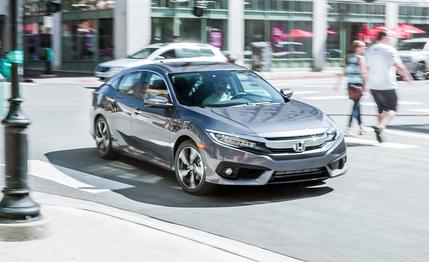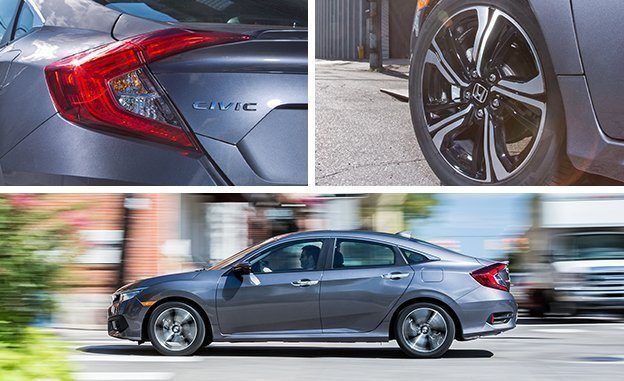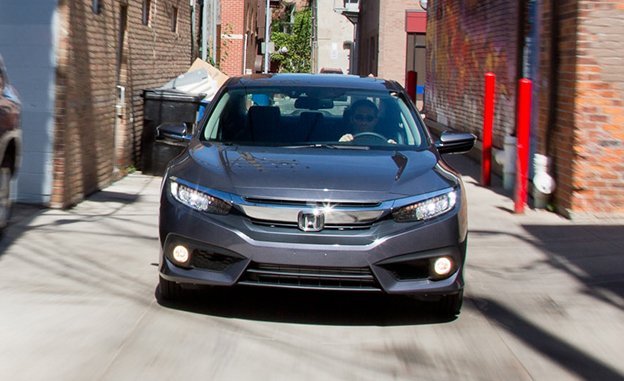
 Instrumented Test
From the December 2015 issue
Instrumented Test
From the December 2015 issue
Honda will undoubtedly look back on the ninth-generation Civic, that unlovable lump of cheapness, as a lesson in continuous improvement. In so repeatedly flexing its renowned rapid-product-development muscle—overhauling the all-new 2012 Civic just a year later and then adding substantial equipment including a new transmission for 2014—Honda has surely grown stronger. It certainly righted the ship from a business standpoint. Civic sales boomed over the past three years, even if enthusiasts, ourselves included, haven’t much praised the product of Honda’s face-saving efforts. Yet this is not the sort of company to content itself with popularity. Honda has traditionally sought critical acclaim as well, with cars that are more like Spielberg films than blockbusters from Michael Bay.
Fade in, then, on the 10th-generation Civic.
Resembling nothing so much as a shrunken Accord Crosstour, this sedan only appears to be a hatchback. (Additional body styles, including a coupe and a four-door hatchback, also will be available.) And the new Civic rides on a platform that will be shared with the next Accord.
As with other recent Hondas, the top-of-the-line Civic is now called Touring. It’s an apt moniker for a car that plants all four tires on the practical side of a compact-segment continuum that ranges from the appliancelike Toyota Corolla to the apex-predator Volkswagen GTI. But this is also to say that the new Civic is well planted. Among its remedies to the outgoing model are the abilities to go and turn quite well.


A new 1.5-liter four-cylinder available in the pricier trims makes 174 horsepower at 6000 rpm. Fitted with a single-scroll turbocharger pumping up to 16.5 psi of boost, its 162 pound-feet of torque makes it a small-displacement Honda engine with heretofore unheard of grunt from a stoplight. The power is felt but not heard, the engine’s voice corked by the turbocharger and the new car’s extensive sound isolation. Lesser Civics get a naturally aspirated 2.0-liter with only 158 horsepower, which still shames last year’s 143-hp 1.8-liter four. The 1.5-liter engine, the first turbo the Honda brand has offered here in a car, is good enough to speed the 2924-pound 2016 Civic from zero to 60 mph in 6.8 seconds, cutting two seconds off the old car’s run.
Spoiler alert: The Civic performs this feat with a continuously variable transmission tucked between its crankshaft and constant-velocity joints. At least the CVT mostly behaves itself, with the turbo four’s 1700-to-5500-rpm torque plateau keeping it from chasing the ends of the tachometer with your right foot’s every twitch. There is some turbo lag from a standing start, but once revs build, throttle response is better than with most CVTs. Put the transmission in S rather than D and the engine is kept spinning about 1000 rpm higher so that the turbo spools up more quickly. The CVT even does a reasonable imitation of a conventional automatic when the driver mashes the throttle pedal to the floor, “upshifting” at its 6000-rpm power peak. But just as in last year’s CVT-equipped Civic, there is no manual mode to control the ratio slide. At this point, no manual transmission is offered with the turbocharged engine, either, though Honda will sell you a six-speed with the 2.0-liter.


The Civic’s structure is solid and stiff, and the ride quality is excellent. Thick anti-roll bars (1.0 inch in front and 0.7 inch in the rear) help the front struts and rear multilink suspension keep body movements in check. The wallowing understeer common in this class has been uncommonly banished; brake-based torque vectoring crisply points the car into turns in a way the old Civic could never manage. The new variable-ratio electrically assisted power steering is about 10 percent quicker than before, though it’s still too flavorless. Turn the wheel past its annoying on-center dead spot and it does weight up, but without telling you much about what the front tires are doing.
They were mostly squealing during testing. The Civic’s 0.82-g performance on our skidpad trailed the last Civic sedan we tested in 2014. Braking was also off the pace, the car taking 178 feet to stop from 70 mph, 13 feet more than the old model. We blame the Civic’s all-season Firestones, sized at 215/50R-17, for letting down the improved chassis. With slightly more sidewall than the old model’s 45-series tires, it’s a sure bet that this rubber was selected for reasons besides its ability to grip the road, such as ride comfort and low rolling resistance.